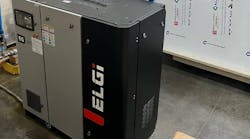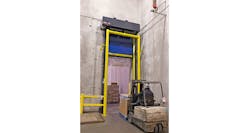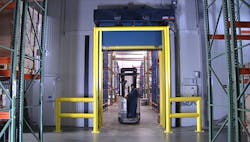New distribution centers and warehouses connected to production facilities tend to be taller than they were thirty years ago, with clear heights pushing up 24, 28, 32 feet, and lately, 36 feet. Concern over adequate square footage for storage has been replaced with attention to cubic footage.
Demands for higher ceilings are coming from manufacturers of consumer products, retail – e-commerce especially – food processors and food storage. The cold storage sector is particularly interested in raising their roofs.
For these facilities, taller storage facilities mean…
- More efficient material handling. Product storage going up rather that out means less aisle length for material handling vehicle access.
- Reduced real estate costs. The higher ceiling requires a smaller building footprint, which leads to…
- Reduced energy costs. A smaller footprint translates into a smaller roof area, which diminishes heat loss.
- Increased capacity. By raising the roof from 32 feet to 36 feet for the same footprint, the facility can handle an additional rack of pallets for a storage increase of 10 to 25%.
With positive changes always come collateral considerations. Take sprinkler systems for example. Sprinkler heads must be capable of handling greater water flow to compensate for the height.
Column spacing also must be increased to handle the larger forklifts needed to reach the higher pallet positions. And to enable forklift access to the taller storage room, taller doors naturally need to be installed. Further, to maximize all of the benefits of a higher ceiling facility, the doors should be high speed - capable of opening 60 to 100 inches per second.
Creating a taller facility, whether through expansion or new construction, means that automated and multilevel pick modules can be integrated into facilities to improve order fulfillment efficiency. For operational and budgetary reasons, many operations with tall facilities must choose between using forklifts to handle and store product before it goes to market or investing in an automated storage and retrieval system (AS/RS).
If the facility goes with forklifts, doorways of at least 16-ft. high are needed to accommodate the high masts. As an indication of the trend toward taller facilities, over 10% of the doors we have shipped out are 16 feet or taller, and that percentage is increasing.
Here are three ways high-speed doors maximize the benefits of high ceilings.
1. Downtime
The smaller footprint means less linear wall space, so these rooms have fewer doorways. Doorway downtime becomes a big issue for facilities with minimal access points.
Palermo’s Pizza is one of the country’s fastest growing pizza makers under their own brand name and private label. Just a few short years after building/moving into a new facility, increasing demand for their product led Palermo’s to conclude that they needed more space. Rather than relocate to an area farther from their workforce, they added 64,000 sq. ft. to the existing operation, including a 40-ft. high ceiling in the freezer storage room.
The smaller footprint means less aisle distance for faster access to the product. But the reduced overall linear wall distance also means fewer doorways – just five in the case of Palermo’s. Downtime of any of these doors would be critical for Palermo’s.
High-mast forklifts requiring 18 ft. of clearance at Palermo’s can go through these doorways hundreds of times a day. The extreme cold and the high demand to meet short deadlines forces drivers to move quickly.
However, slow-opening door is a target for forklifts because drivers can misjudge if the doorway is clear; they might clip the bottom of the door as it rolls up. Losing even one doorway due to a vehicle collision can severely disable the operation’s tight schedules and strain customer relationships.
Fast doors make collisions with their panels nearly impossible. The fastest doors can provide a clear doorway in less than two seconds, allowing unimpeded traffic access for even the tightest approaches to the doorway.
According to Palermo’s facilities engineer Steve Daniels, “our guys are going back and forth through that freezer all day long, taking raw materials to the line. If we can’t keep that flow going, we’re shut down.”
In the very rare case the door does get hit, most models have a breakaway/fast reset feature that has the door back in operation in just seconds. Consequently, door repair crews – a common sight in many operations – seldom have to pay a visit to the facility except for an occasional tune-up, saving repair costs.
When it comes to routine door maintenance, advanced electronics in the high-speed door controller enables adjustments to door operation to be made at floor level, a real benefit when doors are 18 feet tall. Meanwhile, the man-lift stays parked.
These electronics systems offer total digital control and self-diagnostics to minimize maintenance surprises, too. The AC drive enables soft starts and stops, while providing smooth motion at the door’s high speeds for longer component life. High-speed doors can further reduce maintenance by eliminating coil cords usually attached to the bottom bar and communicating wirelessly with the controller – wherever it is mounted – to continually track door operation and provide greater safety.
2. Faster Traffic Flow
Every second counts in a busy operation where doorways are accessed hundreds of times a day. A high-speed door can be opened and accessed in only seconds, saving hundreds of accumulated man-hours a year just waiting for the door to open. This speed allows for better utilization of human resources and investment in equipment.
3. Sustainability
For cold storage operations, the temperature differential between the freezer room and the chilled dock can be approximately 40 degrees. A high doorway typically has about 160 square feet of exposure area. A considerable amount of frozen air can escape the freezer room when these high doors are open.
Lo-temp, high-speed doors reduce air infiltration with fabric panels that cover the doorway. Some models even feature insulated panels that provide additional R-value.
Recent research also has found that the high speed more than compensates for any of the doors’ insulation deficiencies. When a door is cycled more than 55 times a day, a high-speed door starts to save more energy than a standard door. In a typical busy facility, 55 cycles can occur in a matter of just a few hours.
When closed, a high-speed door does an excellent job of sealing the doorway along the entire perimeter. Along the sides of the panel, guides envelop the panel edges to stop energy from escaping the room. Combined with a floor-hugging gasket and brush gaskets along the header, cold air is well contained.
For the Palermo’s operation, with freezer storage near production, there are both sustainability and productivity concerns. Daniels notes that with their freezer at -15 degrees, “every time the door opens I’m losing refrigerated cold air to my production space.”
Daniels has no quantifiable figures on the energy savings from the high-speed doors, but says,“ I can see a change in my compressor usage.”
Although less of a factor for non-lo-temp operations, some manufactured products may be temperature sensitive and may require controlled storage away from ambient docks. Though the energy savings are not as great as with cold storage, coupled with the other benefits of uninterrupted operation and traffic flow high-speed doors may offer additional significant benefits in these environments as well.












